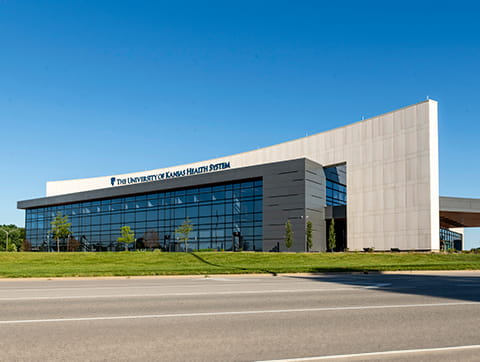Bronchiectasis
Bronchiectasis is a chronic lung condition that damages the bronchial tubes of your lungs, affecting air flow and causing inflammation. The effects of bronchiectasis cause flare-ups that can leave you short of breath, and lead to other long-term health concerns. The American Lung Association estimates that bronchiectasis affects between 350,000 and 500,000 adults in the U.S. While people of all ages can have the disease, it is most common in those over age 75, and it occurs more often in women than men.
Specialists at The University of Kansas Health System have collaborated to form a dedicated bronchiectasis care team. Our experts work together to provide you with advanced care that includes specialized evaluations, support groups and access to new research studies so you can manage the symptoms of bronchiectasis and enjoy a more normal daily life.
What is bronchiectasis?
Bronchiectasis causes damage to the major airways in the lungs, permanently widening them. This type of damage in your airways makes them less able to effectively clear mucus, which increases the risk for serious infection. Frequent lung infections and airways blocked with mucus are common in bronchiectasis.
Because the lungs cannot clear properly, flare-ups are one of the main concerns of bronchiectasis. During a flare-up, also known as an exacerbation, it's hard to catch your breath and you likely will cough up phlegm.
We offer a variety of appointment types. Learn more or call 913-588-1227 to schedule now.
Types of bronchiectasis
Bronchiectasis may be brought on by damage from other conditions that affect the lungs. Because bronchiectasis is often linked to cystic fibrosis, bronchiectasis is usually categorized as either cystic fibrosis bronchiectasis (CFB) or noncystic fibrosis bronchiectasis (NCFB).
Cystic Fibrosis Bronchiectasis
In cystic fibrosis bronchiectasis (CFB), the symptoms and effects of the disease are primarily caused by already living with cystic fibrosis. Cystic fibrosis causes excessive mucus buildup in the lungs, which leads to compromised breathing and recurring lung infections.
Non-CF Bronchiectasis
Non-CF bronchiectasis (NCFB) is when bronchiectasis symptoms develop without already having cystic fibrosis. Other conditions may be present that affect the lungs, such as asthma or chronic obstructive pulmonary disease (COPD). Recurring infections that affect the lungs such as pneumonia, whooping cough, tuberculosis and fungal infections may also cause bronchiectasis. Non-CF bronchiectasis is further classified into different subtypes: cylindrical, cystic and varicose.
Bronchiectasis symptoms and risks
The most common symptoms of bronchiectasis include:
- A chronic cough that typically produces large amounts of mucus
- Chest pain
- Clubbing (thickening of the skin under your nails)
- Shortness of breath
- Wheezing or whistling sounds when you breathe
The chances of developing bronchiectasis increase if you have a related lung condition, like COPD. Recurring pneumonia can also put you at risk for developing bronchiectasis. Additional risk factors for getting bronchiectasis include:
- Allergic bronchopulmonary aspergillosis (an allergic reaction to a fungus called aspergillus)
- Cystic fibrosis
- Immunodeficiency and auto-immune disorders
- Lung infections or injuries
- Reflux
Bronchiectasis diagnosis and screening
To diagnose bronchiectasis, your doctor will start by taking a complete medical history. Your doctor will also look for underlying conditions that could be responsible for your bronchiectasis symptoms, which can look similar to other disorders.
Tests your doctor may use to confirm a bronchiectasis diagnosis include:

Find a doctor
Doctors at The University of Kansas Health System are care providers and researchers at the forefront of new medical discoveries. From primary care to complex conditions, we offer hundreds of specialists.
Bronchiectasis treatment
Bronchiectasis is a chronic, progressive condition. There is no cure, so treatments focus on symptom management and improving overall quality of life. If symptoms of bronchiectasis are caused by an underlying condition, then that condition requires treatment first.
Treatment options for bronchiectasis include:
- Antibiotic medications to treat infections
- Anti-inflammatory medications
- Medications that thin mucus and help make your coughs more productive
- Physical removal of mucus or blockages
- Exercise
Your doctor will also recommend different treatment approaches for managing exacerbated symptoms during a flare-up compared to daily maintenance of symptoms.
Why choose us for bronchiectasis
The University of Kansas Health System's bronchiectasis multidisciplinary care team provides a specialized evaluation and includes pulmonology and infectious disease specialists. Our physicians subspecialize in research and innovative treatment of nontuberculous mycobacterial (NTM) lung disease and bronchiectasis, and caring for patients with these diseases.
Because we are part of an academic medical center, you have access to advanced treatments and care, which may include clinical trials that aren't available anywhere else in the region. You'll also have access to support groups for bronchiectasis and NTM lung disease.
Your bronchiectasis care team
Your bronchiectasis care team includes:
- Pulmonologists
- Infectious disease experts
- Pharmacists
- Other specialists as needed
Bronchiectasis resources and support
Here are a few organizations that offer information and resources for people with bronchiectasis:




